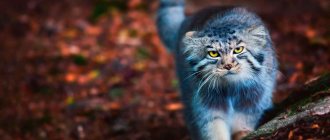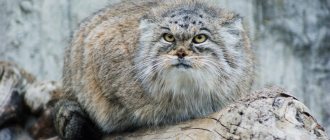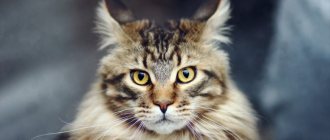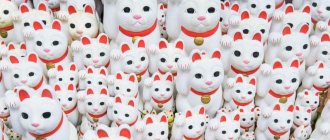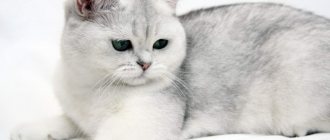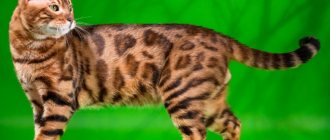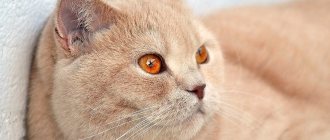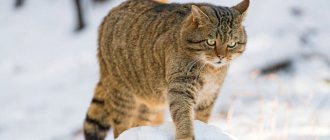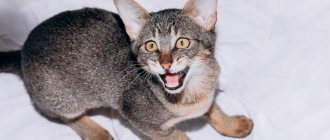Manul is a representative of the wild cat world, which, according to global network ratings, is one of the most popular exotic animals. Unusual long hair, small ears pressed to the head, and the intelligent look of amazing eyes made this cat a real Internet star.
Do not forget that this is not a breed of cute pet, it is a wild predator that is unlikely to ever be able to get along with a person.
History of the discovery of the Pallas's species
The wild forest cat Manul owes his discovery to the German naturalist Peter Pallas, after whom he received his scientific name. The species was discovered and described by a natural scientist in 1776 while exploring the Caspian steppes.
This predator of the cat family is one of the oldest animals on the planet, which has been practically untouched by evolutionary changes.
Scientists believe that Pallas's cat looks the same as it did millions of years ago. The little animal was luckier than, for example, saber-toothed tigers.
The word “manul” is Turkic and scientists do not know its exact meaning. Most likely it means "cat". Although the indigenous population of the Caspian region and the neighboring Mongol tribes treated this animal not only with respect, but also with the highest respect, they practically deified the beast.
In the scientific world, the Pallas's cat has long been classified as a wild forest cat, but as a result of an in-depth study of the characteristics of the species, scientists have identified the animal in a separate class with the name Otocolobus manul or Felis manul.
Feeding the cat
The cat is then healthy, active and cheerful when it receives a balanced diet. It must contain proteins, fats, carbohydrates, vitamins and various microelements.
- The main part of a complete diet consists of meat (lean beef, rabbit, chicken). In addition to this, vegetables and cereals (barley, buckwheat, oatmeal, wheat) are required. Fish can be given sometimes and certainly boiled.
- Cats willingly eat offal - kidneys, hearts, lungs. About once a week you need to give a raw or boiled egg.
- Fermented milk products contain a lot of nutritious protein, so they are very healthy for pets. Every day you need to include kefir, yogurt, cottage cheese or sour cream in your diet.
- Any vegetables will do except potatoes. Among the representatives of the cat family there are also those who are not averse to eating fruit. These products can be given in any quantity.
You should not feed cats fatty, salty, smoked or sweet foods. Therefore, food from the master's table is contraindicated for them. The pet's diet should be varied, but it should not be changed too often, as the animal gets used to certain foods.
Many owners make their lives much easier by purchasing ready-made industrial cat food. They are completely balanced and are an excellent and convenient feeding option for pets.
The main thing is to have an idea of the types of these feeds in order to make the right choice. There are many advertised, fairly cheap brands that can cause irreparable harm to a cat’s health.
It is recommended to purchase premium and super premium food, which are made from high-quality raw materials, contain all the necessary nutrients and are almost completely absorbed.
Premium food has many advantages, the main ones being that you can take the food with you when traveling with your pet, as well as leaving your cat at home for a long time, without worrying that it will go hungry.
Such food can be stored for a very long time. Especially in such cases, an automatic feeder comes to the rescue, capable of dispensing food in the required dosage after a certain period of time.
Mr. Cat recommends: characteristics, habitat
The word "Otocolobus" from ancient Greek means "dwarf ear". The animal has really small ears; against the background of voluminous thick fur they are simply lost.
This is a small animal, hardly larger than an ordinary domestic cat. Body length is from 50 to 65 cm, the tail is long, about 20-35 cm. The weight of the predator is only from two to five kilograms. This is where the resemblance to a pet ends. The Pallas's body is dense, strong, muscular, very often covered with long (up to 7 cm) hair. There are up to nine thousand hairs per square centimeter of skin.
The head seems small in comparison with the spherical body, and the bright yellow eyes have an unusual pupil - it always remains round, without taking on a vertical shape, like in any other feline. The animal has even longer hair on its cheeks – thick “whiskers”.
The distinctive characteristics of Manul are as follows:
- strong, tightly knit body;
- short strong legs;
- long thick tail with a rounded tip;
- small bulging golden eyes with a round pupil;
- long thick wool;
- ticked color, main background gray and white;
- charcoal stripes on the body and tail;
- two black lines on the cheekbones;
- bleached areas of fur on the tips of the ears;
- the ears themselves are very small, set low and wide on the sides of the head;
- the head is small with thick sideburns.
The manul's fur coat is undoubtedly the thickest and fluffiest among all felines, which makes it possible to assume that with a similar coat, Persians are distantly related to this unusual and interesting predator. The animals are also similar in their rounded body shapes and unusual skull structure.
The color of the Pallas cat is dominated by ocher-fawn and grayish tones, but due to ticking, the entire coat appears dusted with snow dust. On the chest, abdomen and inner surface of the paws, the color of the fur is rather brown with the same snow dust.
These animals prefer to live in regions with a sharply continental climate.
A thick coat with a thick undercoat makes it easy to tolerate significant temperature changes. At the same time, short paws make it difficult to move through deep snow cover.
Prefers steppe and semi-desert mountain zones, small hills, intermountain basins with thickets of bushes, stone deposits and crevices in the rocks. It can exist in the mountains, rising to a height of 3-4 thousand meters above sea level.
Very rare in forests and lowlands. Most often, Pallas's cat can be found in Central and Middle Asia, where they inhabit steppe regions with windy areas with little snow, as well as in the mountains and foothills of Tibet and Nepal. There are also small populations of Pallas's cat in Mongolia, China, Transbaikalia, Kashmir and the Caspian lowlands.
Fluffy charmer, or why can’t Manul be a pet?
The manul cat (Felis manul), which is the symbol of the Moscow Zoo, is a rare and poorly studied animal. This predator has lush, valuable fur, which gives the Pallas's cat a massive appearance. The Pallas's cat differs from ordinary cats in having a flat, blunt muzzle with whiskers - tufts of long hair on the cheeks. The Pallas's cat has short legs and a thick tail that looks like it has been chopped off. The pupils of the Pallas's cat are noteworthy - in bright light, unlike pets, they remain round. The color of the fur varies between light gray and fawn-ocher, with dark stripes and spots scattered across the face and tail. With a body length of 52 to 65 cm, manul reaches a weight of 2-5 kg. It appears large and heavy due to its thick, long fur.
Pallas's cat lives in a vast area from the Caspian Sea to Transbaikalia. Inhabiting steppes, deserts and mountainous areas, this representative of the feline chooses areas covered with rocks, stones and thickets of bushes. During the day, the Pallas' cat rests, preferring to stay awake in the early morning and in the dark. The cat's diet consists of mouse-like rodents; occasionally it hunts hares and birds. Short legs do not contribute to fast running, so the Pallas's cat prefers to hide its prey. It escapes on rocks and trees, but this does not happen often, since the Pallas cat has practically no enemies in nature other than humans. But he also tries not to catch his eye. Until now, due to the secrecy of this animal, its habits and lifestyle have been poorly studied.
The exact number of Pallas's cats is not known; in Russia it reaches approximately 2500-3000 individuals. In captivity, these cats are not frequent visitors. The Pallas's cat, even having grown up next to a person from birth, always remains wild and distrustful. There are known cases when Pallas' cats raised at home were transferred to zoos because of their aggressiveness. It has not yet been possible to achieve stable reproduction in captivity, although research in this direction has recently intensified. The Pallas cat is listed in the Red Book and measures are being taken to protect and reproduce it.
Comments and pings to this post are prohibited.
Varieties of Pallas's cat
Pallas's cat has three subtypes:
- Otocolobus manul manul or Siberian Pallas's cat is found throughout most of its natural range, but is most typical for Mongolia, China, and Russian Siberia. The animal has a grayish, rather light color.
- Otocolobus manul ferruginea is known as the Central Asian Pallas's cat. This animal has a darker brownish-red color with brown stripe markings on the body, tail and face. It lives mainly in the foothill and steppe zones of Iraq, Kazakhstan, Kyrgyzstan, Turkmenistan, Uzbekistan, Tajikistan, Afghanistan, and Pakistan.
- Otocolobus manul nigripecta or Tibetan Pallas's cat is characterized by the darkest color, in which ocher and grayish tones predominate. In winter, the fur develops a silvery sheen. The main natural habitats are Kashmir, Nepal and Tibet.
In our country, the distribution area of Pallas's cat is limited to three zones - eastern, Transbaikal and Tuva-Altai.
In the east, Manul lives in the steppes of the Chita region, in the Trans-Baikal Territory, and is found in the Buryat forest-steppe and steppe regions. In Altai and the Tuva Republic, the animal has been practically exterminated; small populations are observed only in the southeastern regions.
Now Manul is also artificially bred in Azerbaijan in the Zangezur National Park.
What affects the cost of a British kitten
- The main reason influencing the price of a British kitten is its class. Show class cats are recognized as the most expensive and elite. For one small lump they ask for 15-30 thousand rubles, focusing on age, gender, pedigree, color.
- British breeding class kittens are sold a little cheaper. The price for these pets ranges from 9-15 thousand rubles.
- The most budget option will be the British pet class. A good kitten of this class costs between 3-6 thousand rubles. This cat will make a wonderful pet, but he will definitely need to be spayed/neutered.
- At a reasonable price, it is possible to purchase a purr without documents. Among their representatives there are British, which basically correspond to the breed standards, and those that only partially resemble them.
Not everyone knows how much you can buy a fold-eared kitten from a breeder. Many people want to save money, and in the hope that they will be lucky with a pet, they take a kitten from their hands on a website on the Internet, a bird market, or through an advertisement in a newspaper. However, some later regret it, because the kitten is growing, and it is not a fact that it will correspond to its breed. Flaws in the structure of the body, color, etc. are not excluded. But it is not yet known what kind of character the pet will have?!
Peculiarities of Pallas's behavior
Pallas's cat leads a solitary lifestyle and is not prone to moving long distances. Manul makes shelters in rocks, caves, narrow holes, and also occupies burrows left by other animals - badgers, marmots, foxes. This predator behaves very slowly in everyday life, even seeming clumsy and clumsy.
During the day he usually sleeps in the den, and at dusk he goes out hunting. Color helps the animal blend in with its environment and be invisible. Both when hunting and when defending, Manul prefers to hide and wait; he cannot run fast and does not like rapid movements.
It can quite deftly climb rocks and climb into a narrow crevice, where a large predator definitely cannot reach. But Manul practically does not know how to climb trees.
If a cat is alarmed, it emits a characteristic snort or a hoarse rumbling sound.
Such a high level of caution in Pallas's cat is explained by a large number of natural enemies - wolves, wild and feral dogs, eagles, eagle owls, and bears.
The Manul can watch its future prey from ambush for hours, often tracking it at a hole, but the attack on the victim can be swift and unmistakable.
Manul seems gloomy and unfriendly. Indeed, this animal does not really favor even its relatives.
Pallas's cat is perfectly adapted to life in the steppe. The animal is not afraid of dry, frosty wind. The body is protected by long hair with a thick undercoat, and the eyes have special membranes that, due to frequent blinking, protect the cornea from dehydration.
Despite his slowness, the Manul is able to cover a short distance very quickly, but then needs a long sleep. This is due to the small size of the heart sac, due to which the vascular system cannot withstand long-term loads.
The animal's hearing, vision and sense of smell are excellent, so the steppe is its home. He is able to sense danger from afar and hide, crawl into the narrowest crevice, and if necessary, he can defend himself, growling menacingly and showing sharp fangs.
What does the wild cat eat?
Photo: Wild animal manul
The prey of Pallas's cat is very diverse. Wild cat hunts:
- voles;
- marmots;
- protein;
- various birds (including larks, aviaries and partridges);
- insects;
- reptiles;
- scavengers.
The steppe manul cat hides during the day in small abandoned caves that previously belonged to marmots or foxes. Since Pallas' cats are extremely slow, they must position themselves low to the ground and get close to their prey before leaping. To avoid becoming prey for eagles, wolves, red foxes or dogs, they move in short steps and then hide while eating.
The highest activity in searching for food for the Pallas's cat is at dusk and dawn. Wild cats can also hunt during the day. Other predators, such as corsac foxes, red foxes and European badgers, rely on the same food sources as Pallas's cats. To avoid competitive exclusion, there is a principle that states that species that rely on the same resources cannot coexist in the same habitat. Based on this, Pallas' cats have adapted seasonal food-seeking behavior.
In winter, when there is not enough food, Pallas cats actively search for hibernating or frozen insects. Winter is the time for badgers to hibernate, so wild cats successfully avoid competition for prey.
Diet
At night, the predator goes out hunting, slowly making its way through tall grass or sparse bushes. The cat makes sounds extremely rarely.
Manul prefers not to go far from his lair, so seeing him near human settlements is almost impossible. Pallas's cat will never be left without prey; his hunting skills are at a high level.
The main victims of the predator are small rodents. In addition to mice, gophers, pikas, he will not refuse to catch a hare, a marmot or even a small bird. However, in times of hunger the animal does not disdain even insects.
The approximate diet of the Transbaikal Manul under natural conditions consists of more than half of Daurian pikas, 1/5 of the daily volume it eats bugs, and about 10% of the prey consists of pigeons, swifts, partridges, bluetails, and quails. The remainder comes from ground squirrels, jerboas, hamsters, voles, berries and plants.
Hunting and food
Manul is endowed with patience. When hunting, he does not rush, but calmly waits for his prey in ambush. The predator guards near the hole and attacks from the back.
Cats hunt Daurian peeps and small rodents . Animals feed on hares, marmots, and birds. If the hunt is unsuccessful, the cat will be satisfied with prey such as insects. The animal eats plants and berries.
Be sure to read:
A cat that looks like a lynx: the best domestic and exotic breeds, features of their maintenance
A predator attacks at night. In the warm spring and summer, the cave cat loves to bask in the sun, so it hunts during the day.
In zoos, pets are fed rodents and beef.
Puberty and reproduction
Despite his complex and unfriendly character, during the mating season Manul is transformed. Observations of small populations of animals made it possible to establish that the cat is very affectionate with his girlfriend.
First, the cat must be won back in battle with rivals, because the female is in heat for only 2 days out of 365 and you have to hurry.
The mating season occurs once a year and most often occurs in February-March. The female bears the offspring for about two months, an average of 60 days.
In mid-spring, from two to six blind, fairly large (up to 200 grams in weight and 12 cm in length) kittens appear in the den. The babies' coat is much darker than their parents' and they are absolutely helpless.
The cubs grow quickly, by one month they begin to crawl out of the hole and try solid food, and by four or five they already know how to hunt on their own. Only the mother raises them; after mating, the males leave the fertilized female.
Adolescents reach sexual maturity by 10-11 months and begin to live independently, but individuals can be considered fully adult from 15-18 months.
In the wild, wild cats live for 12-13 years, in captivity longer - up to 20-23.
Maine Coon kitten size
Maine raccoon cats are born quite large in size and weigh an order of magnitude more than kittens of other breeds. For example, if the weight of a newborn Persian breed varies between 125-150 g, then a Maine Coon kitten is born weighing 125-170 g. According to average statistical data, the weight of a newborn Maine Coon is significantly influenced by the number of kittens in the litter, therefore , the fewer kittens, the greater their weight.
The rate of growth processes and weight gain in a newborn directly depends on its gender, as well as the characteristics of the parental genotype. As a rule, kittens born from a physically healthy and massive cat grow and develop faster. The kitten's growth can be negatively affected by the cat's use of hormonal drugs that can provoke a pronounced endocrine imbalance.
In order for a Maine Coon kitten to gain height and weight correctly, it is necessary to comply with a number of requirements, including ensuring optimal sanitary and hygienic conditions in the place where the animals live, preventing stressful situations in the form of noise and temperature changes, and proper and balanced nutrition for the nursing cat and kittens.
The suckling period lasts from birth until four weeks, and is also characterized by constant and stable growth. In the first ten days, the kitten’s body weight doubles, and by a month the weight becomes approximately four times greater.
Captivity
Exotic appearance and small size, commensurate with the height and length of a pet, often mislead people. It is almost impossible to make a family pet out of a Pallas cat, even if you manage to buy a small kitten.
To all the difficulties of socialization are added health problems. As practice shows, in captivity up to 90% of Pallas' cats become infected with toxoplasmosis. Read about this disease in cats and people. In the steppe with bright sun and cold air, cats do not get sick, but at the slightest deviation from natural conditions, microorganisms are activated, and the infection seizes the animal.
Even in the conditions of a zoo, where the best veterinary specialists monitor the Pallas’ cat, and the living conditions are as close as possible to natural ones, not all animals are able to be released. This is another factor for refusing to keep Pallas's cat in a private house or apartment.
There are other reasons why you should not try to turn Pallas's cat into a pet.
This animal has a wild, quarrelsome disposition. Even small kittens, taken from their mother early, become uncontrollable during puberty.
At three or four months, little Pallas's cats awaken all the makings of a hunter, then not only furniture and walls, but also people can suffer from sharp claws and teeth. Although an adult animal reacts to people quite calmly, it does not show any signs of sympathy. Moreover, the cat will always try to hide and avoid any contact with the owner and household members.
Long, harsh hair will also cause a lot of trouble. Under constant stress, the animal will shed year-round, leaving clumps of hair everywhere.
Read about why cats shed and what to do about it.
Character and behavior
Creating the image of a wild cat, the imagination draws pictures of an unbridled predator, ready to fight and chase. The character of the Pallas's cat is very different from the usual associations.
This is an extremely cautious animal, not ready to risk its health for the sake of the most coveted prey. In case of danger, he will not rush to run headlong - this is not his strong point.
The Pallas's cat is a master of camouflage; he can sit in a shelter, without moving or making a single sound, for quite a long time.
He feels good in the early morning and early hours of the night. The rest of the time, the cat is lethargic and inactive, giving preference to sleep and rest, he saves energy for really important matters - obtaining food and preserving his life.
When answering the question whether it is possible to tame a Pallas's cat, one cannot give a definite answer: a wild cat at home is an unusually rare and little-studied phenomenon.
A few owners of pets of this breed say that the animal has a cool disposition, is non-communicative and aggressive. He quickly forgets the person who fed him and shows the nature of a predator from the age of 3-4 months.
The manul does not like company and games, and tries to avoid both humans and other pets. In response to stroking, he may scratch or bite strongly.
Perhaps the popularization of the breed will do its job, and after just a few generations of animals born in captivity, Pallas' cat fans will be able to safely acquire furry friends.
Purchasing a kitten
It is almost impossible to legally buy a Pallas cat. This animal is now on the verge of extinction, is listed in the International Red Book and is protected by the states of many countries.
Nevertheless, occasionally offers for the sale of a rare animal still appear online with a price of five thousand dollars.
It should be remembered that the acquisition of smuggled Pallas cat is illegal and strictly punishable. And what's the point of buying a kitten that will never become tame, no matter how much you play with it and feed it by hand?
Even if the baby grows up next to ordinary kittens from a domestic cat, sooner or later the wild nature will take its toll. Not only the furnishings of the apartment can be damaged, but people’s health is at risk.
Pallas's cat is now very rare in its natural distribution areas. According to tentative estimates of scientists, no more than two or three wild cats live per ten square kilometers in their native habitats.
It is believed that the total number of Pallas' cats living on the territory of the Russian Federation is no more than 3500-3700 individuals. To this day, this animal is hunted by poachers for the purpose of obtaining fur skins and catching cubs.
Populations are also decreasing for natural reasons - the food supply decreases every year due to the widespread destruction of rodents, many juveniles die from large predators and infectious diseases, winters with a lot of snow and ice have a bad effect on the number of cats.
Since 2013, our country has had a program to preserve the number of Pallas's cat in the Trans-Baikal District. They are trying to breed animals in the Daursky Nature Reserve.
At the end of the last century, animals were kept in only 15 zoos in the world, and their total number in artificial conditions did not exceed 40 units. Now this figure is slightly higher; in captivity, predators reproduce quite well, but high mortality among offspring due to toxoplasmosis remains.
Manul in the food chain
The Pallas cat animal is clearly not at the top of the food chain, although it is considered a predator.
This is all due to some of the slowness of the beast, its reluctance to enter into open conflict, and its inability to move quickly.
Cat's food
The animal's diet includes pikas, mouse-like rodents, hamsters, voles, gophers, hares, marmots, and various birds. The cat will happily taste the quail that did not have time to fly away, and in severe times of hunger it will not refuse even a cricket.
The hunting process occurs either in the morning, or in the evening and all night.
The manul cat hides in a place convenient for waiting for the victim, patiently looks out for it, and only then pounces on the careless animal. Short legs are rather a hindrance here, so he has a chance to catch prey suddenly: in a run, a wild cat will lose.
In winter hunting, warm, thick hair together with short limbs makes the cat clumsy, so the animal prefers to forage for food in open, windy spaces.
Enemies of Pallas's cats
global $ads_google;
//data-ad-slot=”2475549904″ $ads_google = empty($ads_google) ? false : true; ?> if ($ads_google == false) {?> $ads_google = true; ?> } ?> The physique and habitat of the wild Pallas's cat makes their existence unsafe. Since cats prefer open spaces, they are open to the view of larger predators, which can be steppe wolves, eagles, golden eagles, and eagle owls. Feral dogs do not miss the opportunity to hunt a fluffy cat.
Nature can also become a serious enemy: if the winter turns out to be snowy, then for cats this means lack of food. Pallas cat kittens that appear by mid-spring can die from infections.
Humans are also considered enemies of the handsome man with a stern expression on his face. People are expanding their own land, making survival conditions more difficult - the food supply is shrinking, and there are more and more stray dogs. Hunters set traps for a hare and a fox, and the unfortunate manula cats .
Adaptability
Representatives of this breed, no matter what conditions they find themselves in, are constantly on the alert. Life in the wild with many other predators, in particular wolves, developed in them certain traits that, through a long evolution, developed and reached their apogee:
- there are membranes on the animal’s eyelids that protect the organs of vision from drying out in strong winds;
- body flexibility and agility are traits that enable the animal to feel comfortable on rocky terrain, easily maneuvering between stones;
- maximum visual and hearing acuity make the Pallas cat not only an unsurpassed hunter, but also allow you to easily hide and evade enemies, sensing a potential threat in advance;
- The Pallas cat's reaction to any irritant in his direction is always immediate, and this quality saves a cat in the wild.
An unusual feature is that the Pallas cat begins to snort loudly and make other strange sounds, thus trying to scare his enemy.
Munchkin - photo and description
Cats can stay in this position for quite a long time, and their small paws hanging along the body complete the image of a kangaroo. It looks very funny, so such animals could not go unnoticed.
Character
Munchkin cats have a rather unique character. The animals have too short limbs, which does not allow them to fully hunt, so “kangaroo cubs” must be kept only at home, NOT OUTDOORS! Taxi cats are not at all worried about being deprived of the opportunity to climb on tables, knock over a couple of porcelain figurines or the owner’s expensive vase - their small paws do not prevent them from “leading an active lifestyle” on the floor of your apartment. After all, they just don’t know how to jump, but they run quite briskly.
You will probably not find such a funny breed as the Munchkin cat anywhere. After all, you can’t look at the way these animals sit on their hind legs in a kangaroo pose, leaning on their tail, without smiling. They are also known as “petty thieves.” No, no, the taxi cat will not steal a piece of meat or fish from you - he “likes” more small objects that can be hidden in a secluded corner
Therefore, if you lose some valuable trinket, do not panic, but rather carefully watch your pet and sooner or later he will lead you to his “cache”
Munchkins are very sociable and easily get along with strangers.
Munchkins are quite resistant to excessive affection and “torment”, which children love so much, so this breed is also ideal for a home where there is a small child. Although, despite the fact that the animals are very friendly, curious and sociable, it is still not worth abusing this - the cat is quite capable of standing up for itself.
Description of the breed
When meeting this exotic animal for the first time, people experience approximately the same range of feelings: at first - pity, then - genuine joy and admiration. After all, unusual short-legged cats will certainly make anyone who sees them smile.
At one time, a lot of controversy arose around this breed: some argued that kangaroo cats were defective animals that did not deserve the attention of breeders, while others, on the contrary, believed that the Munchkin was a rather interesting breed that needed to be further developed.
The head is medium-sized, wedge-shaped with smooth contours. The ratio of head and body sizes is proportional. Adult males have more developed parts of the head than cats:
neck of medium length, muscular, thick; the nose is medium with a slight deflection, which is not a fault of the breed; Widely spaced eyes resemble a large walnut in appearance, located at a slight angle to the ears
IMPORTANT! Eye color is not determined by the color of the animal, the main thing is that the eyes have an even and rich color; the ears are wide at the base and rounded at the ends, located wide and high. When moving, animals hold their tail in a “pipe”
When moving, animals hold their tail in a “pipe”
Paws are one of the main differences between munchkins and their relatives. They are straight and short. Although in some cases there is a slight curvature of the forelimbs towards the inside. As already noted, the front legs are shorter than the hind legs. The weight of short-legged cats reaches 2-3.5 kg, male cats - up to 4 kg.
The coat can be either long or short. In the first case, the wool is silky and dense and has excellent protective properties. An animal of this type has a chic lordly collar. In the second option, the wool is shiny and resembles plush in tactile sensations.
Color. The variety of colors in cats of this breed is amazing, and it has been noticed that the same color looks completely different on long-haired and short-haired dachshunds. The most popular colors of long-haired cats are smoky and silver. For short-haired species - colors of a wide variety of patterns, color points, as well as dark markings on the paws, tail and head. It should be noted that short- and medium-haired munchkins are much more common than long-haired ones.
Munchkin cats are a short-legged breed
Interesting facts about the manul:
- Pallas's cat reproduces well in captivity, but at the same time in zoos there is a problem of high infant mortality from toxoplasmosis. At the end of the 20th century, 35 individuals of this species were kept in 13 zoos around the world.
- 12 post stamps of Tajikistan are dedicated to Pallas's cat; countries such as Azerbaijan, Mongolia and Kyrgyzstan also issued them.
- In Turkmenistan, there is a commemorative silver coin (500 manats) with the image of a Pallas's cat. It was created as part of a series dedicated to rare and endangered animals.
- The Pallas's cat is the mascot of the Moscow Zoo.
- There is a version that the closest relatives of Pallas cats are Persian cats, which are most similar to the latter in physique, structure and coat color, but this relationship has not yet been proven.
Life in the wild
Pallas' cats are cats that lead a sedentary lifestyle; only extreme circumstances can force the animal to leave its hole. Each manul has its own territory, where it will observe with displeasure the presence of other representatives of its own breed.
The cat lives in cozy dens, which are crevices, shelters under stones, and small caves. The Pallas's cat will also happily settle in abandoned burrows of other animals.
With the help of a hole, the animal protects itself from the sweltering summer heat and winter cold. As massive and stern as the manul looks, it is an absolutely non-conflict animal that prefers not to get involved in fights with other representatives of the wild.
The diet is quite varied - the Pallas's cat hunts small birds, eats insects, and small rodents. In addition, the fluffy cat's menu includes gophers, rabbits, and marmots. The Pallas's cat hunts in the following way: it finds the prey, hides, keeps watch, waiting for an opportune moment to attack, and as soon as it is confident in its abilities, and the prey loses its vigilance, it attacks.
The manul prefers to hunt passively, luring its prey for a long time and capturing it with one throw.
The animal is unable to run for long distances - this is due to the modest size of the heart muscle, which is not designed for such loads.
Enemies
In the wild, the Pallas cat is of no interest to other animals. The only representative of the fauna that the Pallas's cat is afraid of are wolves. The cat is also afraid of large birds of prey - eagles and golden eagles, trying not to come into their field of vision.
What determines the size and weight of Bengals?
Domestic Bengal cats owe their physical characteristics to wild, not so distant ancestors. The size of the spotted animals, called leopard cats (Prionailurus (Felis) bengalensis, abureviation ALC), approximately corresponds to the size of ordinary pets of other breeds. However, the legs are longer, and the hind legs are noticeably higher than the front ones. The external parameters of Felis bengalensis vary greatly depending on the habitat. Thus, the smallest, weighing an average of 2.5 kg, live in the Philippines, and the largest Ussuri, weighing up to 10 kilograms, live in the Russian taiga.
Accordingly, both the height and body length of Bengal cats fluctuate greatly in nature. The largest individuals can reach 95 centimeters with their tail.
When characterizing the physical characteristics of Bengals, we must not forget that their breeding involved not only species of wild cats from the subfamily of small cats, but also a whole list of representatives of other breeds. So, how big a Bengal cat grows depends on a number of factors. However, existing weight tables, which were derived as a result of many years of observations, still help to track the correctness of how much a representative of the breed should weigh at a particular age.
Dynamics of weight gain in Bengal kittens
Kittens in a Bengal litter grow quickly. Already by the beginning of the second week of life, a Bengal kitten becomes 2 times larger than those parameters recorded at birth, and this weight ranges from 70 to 120 grams. Of course, the size and body weight of a Bengal kitten depend on the physical characteristics of its parents. Approximate indicators of correct development by month are as follows:
- end of the first week: up to 250 grams;
- end of the first month of life (four or five weeks): from 400 to 500 grams;
- 3 months - about a kilogram;
– 7 months – 4 kilograms;
– 10-12 months – 4.2 – 6 kg.
The weight gain algorithm is uneven, there are the following features:
- a kitten’s growth at 2 months is much slower than before;
— having crossed the figure of 1 kilogram, growth accelerates significantly;
- at 7-9 months there is a new slowdown in weight gain, and female Bengals actively stop growing, and males continue to increase their parameters up to 2 years.
The opposite situation may also be true: a kitten at 4 months has become fat, having gained the maximum weight expected for it at six months or even at 1 year. In this case, you will also need the help of a veterinarian.
Standards for weight and size of adult Bengal cats and cats
Domestic Bengals have impressive sizes as adults: males of the breed can reach 8 kg, and females - 6 kg. The height of a large animal at the withers is 40 cm, and the total length of the body with a tail is approximately 90 cm. The elongated body with amazing flexibility makes representatives of the Bengal breed graceful, which is one of the differences from other purebred pets from the cat family.
Naturally, females differ from males in their appearance and physical characteristics. The difference in weight, and, accordingly, in other parameters, is immediately noticeable. A junior cat that has reached sexual maturity, which is 8-9 months, is almost twice the size of a cat. Its paws and tail are more powerful.
Taking into account the goal - to create a pet that has the external and physical characteristics of small animals living in their natural environment, special standards were developed for the breed. The jury of exhibitions, championships and competitions takes into account, in particular, how athletic the animal is, how it holds its thick tail, the length of which should be average, what the size of the nose, ears and especially convex pads under the whiskers of this breed are.
Possible assumptions
Some felinological associations consider the following physical deviations from the ideal representative of the Bengal breed to be unimportant:
- smaller size of the cat while maintaining overall harmonious proportions (this assumption does not apply to cats);
- the cat’s cheeks are slightly larger than those required by the strict standard;
- the shape of the eyes, which are supposed to be almost round, is visualized as slightly almond-shaped;
— the difference between the length of the animal’s front and hind legs is not very noticeable.
These shortcomings may not affect the decision to award the win to a male cat if all other main parameters are ideal.
Habitat
The optimal living conditions for the furry representative of the cat world are light snow, moderate cold temperatures and a steppe with tall grass. The cat will feel comfortable even among rocky and mountainous terrain. The main thing is that the rocks and mountains have many exits.
The animal's body is not affected by severe cold. Pallas cats have strong immunity and are not prone to any diseases. The habitat of cats includes Transbaikalia and Central Asia, Mongolia, Afghanistan and Transcaucasia, the western part of China.
How many Pallas' cats are left on earth?
According to the World Wildlife Fund (WWF), at the end of 2016, the total population of Pallas's cat numbered about 12 thousand individuals. In our country, most of these rare wild cats live in the Chita region. According to experts, there are from 2 to 2.5 thousand animals in the region. About 200-250 wild cats live in Buryatia and Tyva.
Counting the number of animals complicates their secretive lifestyle. However, even without an accurate determination of the number of Pallas's cats, it is clear that in recent decades there has been a gradual and stable decrease.
Types of ferrets
Before purchasing this animal, you should understand what types of ferrets exist. There are not so many of them, only three, but each species has characteristic distinctive features.
Stepnoy
The steppe ferret is also known as the light-colored, white ferret. You can look at photos of this animal on the Internet, but you cannot see any obvious distinctive features in its appearance.
Main characteristics:
- steppe individuals are large in size. Weighing 2 kilograms, they can grow up to 52-56 centimeters;
- The length of the tail of animals of this species can be about 18 centimeters;
- this species has long guard hairs with a sparse structure;
- The general color is brown, there is an underfur underneath that is dense to the touch, it has a light color.
Forest
They are also called ordinary, black. Animals of this species have small body sizes, its length is only 36-48 centimeters. The weight of an adult can be from 400 grams to one and a half kilograms.
The color of the coat of the black polecat, unlike representatives of the steppe species, does not have sharp contrasts between the color of the legs and the whole body. The main color of the animals is black-brown, and the legs, tail, and chest area are black. Also sometimes there are individuals that are completely white or red in color.
The African ferret or ferret is a domesticated animal that belongs to this species. Sometimes this species is called furo, but scientists use it for albinos. In order to understand what these species look like, you can look at the photo.
The appearance is not very different from representatives of other varieties:
- body length is average, it can be approximately 51 centimeters;
- the weight of the animal can vary from 700 grams to 2 kilograms;
- the length of the tail is 12 centimeters;
- the coloring is the same as that of individuals of the forest species.
Sometimes domesticated ferrets are crossed with wild individuals. Hybrids differ in that they have larger body sizes, but all external features are similar to the characteristics of both species that were used for crossing. The decorative ferret is called honorik. In appearance it is somewhat reminiscent of mink or angora. They have a thick brown underfur that is similar to sable fur. In order to understand exactly what this species looks like, you can look at its photo.
Note! The Angora ferret or Honorik is highly aggressive. These species simply cannot get along with people, for this reason they live only in the wild forest
American
They are also called black-footed ferrets. This is a rare species, which is listed in the Red Data Book in the USA. Every year their number becomes smaller, at the moment they are on the verge of complete extinction. In order to understand what these individuals look like and what differences they have, it is worth looking at photos on the Internet.
Appearance Features:
- The ferret's body size is 31-41 centimeters;
- the weight of individuals ranges from 650 to 1 kilogram;
- the tail has a fluffy edge, its length can be from 11 to 15 cm;
- The main cover is white in color, and the tips of the hairs have a dark color. For this reason, from the outside it seems that the animals have a yellow-brown color.
Ferret breeds have distinctive characteristics that you need to know. On the Internet you can look at photos of animals of a certain species, they will help in the future to distinguish the individual. African individuals are suitable for home breeding; they are most adapted to home conditions and have an easy-going character. But his well-being depends on the necessary care and favorable conditions.
Attempts at domestication
No matter how much zoologists try to tame the Pallas's cat, he is extremely reluctant to live in zoos. Most individuals waste away before our eyes and contract all possible diseases. Their body is adapted to natural conditions, so life in the reserve brings torment to Pallas’s cat.
Some enthusiasts decide to keep such a cat at home. As a rule, the undertaking does not end very well. Pallas cats are not ready to cooperate with people and demonstrate this in every possible way.
The little manul in the house is an unpredictable hurricane , restrained only by the desire to get another portion of food. The cat does not get along with children and cannot be trained.
The owner who decides to make such a purchase will have sleepless nights. Pallas's cat stays awake in the dark, and his activity harms everything in the house. Furniture, sofas and curtains will be torn, and all horizontal surfaces will certainly be sprinkled with wool. This cat is very fluffy.
It is very difficult to find breeders who breed this breed. It is prohibited to catch these animals on Russian territory, and their numbers are constantly declining. Young animals often fall into traps and become victims of large predators. The status of the animal remains rare even in its native lands.
The wild cat Manul is an animal with an unusual appearance and amazing habits. Perhaps this is the only species that does not want to get acquainted with humans and become domesticated. But, despite the hermit lifestyle, Pallas' cat fans continue to love these wayward little savages.
